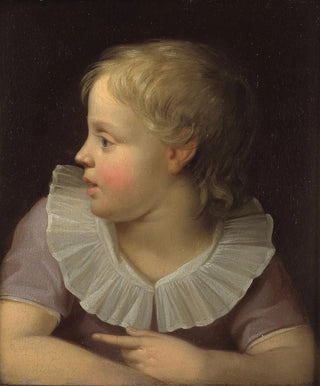Art print | The painter's son Jens Juels Jens - Christoffer Wilhelm Eckersberg


View from behind

Frame (optional)
In the panorama of art history, certain works stand out not only for their technique but also for the depth of their subject matter. "The Son of the Painter Jens Juels Jens" by Christoffer Wilhelm Eckersberg is a perfect example. This piece evokes not only the artistic talent of its creator but also a moment of tenderness and family intimacy, capturing the very essence of the relationship between a father and his son. Through this work, Eckersberg invites us to contemplate not only the emotional landscape of his characters but also the beauty of a bygone era. The soft light bathing the scene, as well as the natural pose of the young boy, make this artwork a true homage to everyday life and the beauty of family bonds.
Style and uniqueness of the work
Eckersberg's style is characterized by meticulous precision and particular attention to detail, reflecting his deep respect for nature and humanity. In "The Son of the Painter Jens Juels Jens," the composition is both simple and powerful. The young boy, dressed modestly, is placed at the center of the piece, immediately drawing the viewer's attention. The colors, gentle and harmonious, create a serene atmosphere, while the light plays a crucial role in highlighting the child's facial features. Delicate shadows add depth to the scene, enhancing the sense of realism. This painting is also a striking example of how Eckersberg manages to blend tradition and modernity, incorporating elements of classicism while aligning with the Romantic movement of his time.
The artist and his influence
Christoffer Wilhelm Eckersberg, often regarded as the father of Danish realism, marked his era with his innovative approach to painting. Born in 1783, he succeeded in establishing himself on the European art scene thanks to his exceptional talent and his ability to capture moments of daily life with rare emotional depth. His influence extends beyond his own works, inspiring many artists of the next generation. Eckersberg also played a key role in the development of the Royal Danish Academy of Fine Arts.

Matte finish

View from behind

Frame (optional)
In the panorama of art history, certain works stand out not only for their technique but also for the depth of their subject matter. "The Son of the Painter Jens Juels Jens" by Christoffer Wilhelm Eckersberg is a perfect example. This piece evokes not only the artistic talent of its creator but also a moment of tenderness and family intimacy, capturing the very essence of the relationship between a father and his son. Through this work, Eckersberg invites us to contemplate not only the emotional landscape of his characters but also the beauty of a bygone era. The soft light bathing the scene, as well as the natural pose of the young boy, make this artwork a true homage to everyday life and the beauty of family bonds.
Style and uniqueness of the work
Eckersberg's style is characterized by meticulous precision and particular attention to detail, reflecting his deep respect for nature and humanity. In "The Son of the Painter Jens Juels Jens," the composition is both simple and powerful. The young boy, dressed modestly, is placed at the center of the piece, immediately drawing the viewer's attention. The colors, gentle and harmonious, create a serene atmosphere, while the light plays a crucial role in highlighting the child's facial features. Delicate shadows add depth to the scene, enhancing the sense of realism. This painting is also a striking example of how Eckersberg manages to blend tradition and modernity, incorporating elements of classicism while aligning with the Romantic movement of his time.
The artist and his influence
Christoffer Wilhelm Eckersberg, often regarded as the father of Danish realism, marked his era with his innovative approach to painting. Born in 1783, he succeeded in establishing himself on the European art scene thanks to his exceptional talent and his ability to capture moments of daily life with rare emotional depth. His influence extends beyond his own works, inspiring many artists of the next generation. Eckersberg also played a key role in the development of the Royal Danish Academy of Fine Arts.






